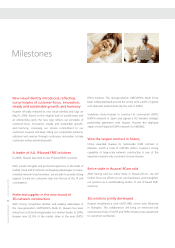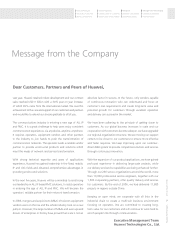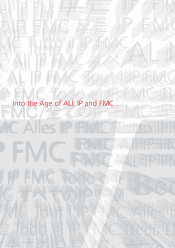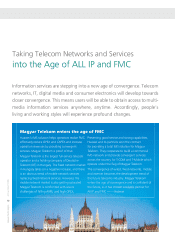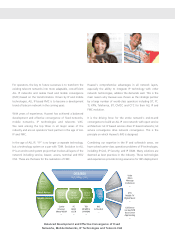Huawei 2006 Annual Report Download - page 16
Download and view the complete annual report
Please find page 16 of the 2006 Huawei annual report below. You can navigate through the pages in the report by either clicking on the pages listed below, or by using the keyword search tool below to find specific information within the annual report.
Huawei Technologies Annual Report 2006
16
With the rapid development of the mobile market, we are well
on our way to expect another two billion mobile subscribers.
The IP based mobile bandwidth solution is therefore becoming a
popular choice for the development and deployment of telecom
networks. IP has been applied in all layers of the mobile network
including service, core, bearer and access. The IP based mobile
network helps build uniform bearer networks and save 40-80%
of HSPA transmission cost. Meanwhile, it simplifies the structure
of the mobile network and promotes network bearer capability.
Using Huawei’s next generation HSPA base stations, which
support IP transport, EMOBILE deployed Japan’s first ALL IP HSPA
network and reduced network transmission cost by 60-80%.
As HSPA network operation and service deployment matures,
users will enjoy the real fun in high speed mobile data services. In
developed markets, 2G network users will switch to 3G networks
at a higher speed and the focus of network operation will gradually
shift to 3G networks. We have launched the UMTS900 solution
which provides better coverage and reduces the cost of HSPA
network construction. Australia’s OPTUS has cooperated with
Huawei and constructed their trial UMTS900 networks. We also
carry out new cooperation programs with Motorola to provide
more powerful and complete UMTS products and solutions and
HSPA solutions for customers worldwide.
The development of GSM technology will continue, while most
operators face the challenges of changing network structure
and increasing network profitability. Huawei’s GSM series
of base stations feature good coverage and high density to
promote the competitiveness of operator networks. Leading
operators like Brazil’s Vivo, Pakistan’s Ufone and China
Mobile deployed Huawei EnerG GSM solutions in large scales.
Meanwhile, Huawei applies 3G and IP technologies to promote
the IP-oriented evolution of GSM. We plan to launch an IP-
based GSM solution in the third quarter of 2007.
The global CDMA market is yet to grow rapidly in the future.
Huawei provides not only end-to-end CDMA2000 products
and solutions from systems to terminals but also professional
services including business consultation and maintenance
service. Continuous R&D investments make Huawei one of the
few major contributors to the UMB architecture.
Huawei is one of the few vendors able to provide end-to-end
mobile WiMAX solutions in the industry. We actively promote
the industrialization of WiMAX. Huawei’s mobile WiMAX can
converge with current CDMA, GSM, NGN and IMS networks
thus realizing cost-effective deployment of mobile broadband
networks.
Mobile Communications Field:
Taking Mobile Networks to IP
UMTS/HSPA solutions provided for StarHub
“We have been impressed by Huawei’s 3G technology roadmap, especially
their ability to deliver next-generation wireless applications and services
quickly. We are confident that Huawei’s solutions will help us deliver an
enhanced 3G experience to our customers.”
Mr. David Storrie,
StarHub’s Head of Network and Wholesale.


